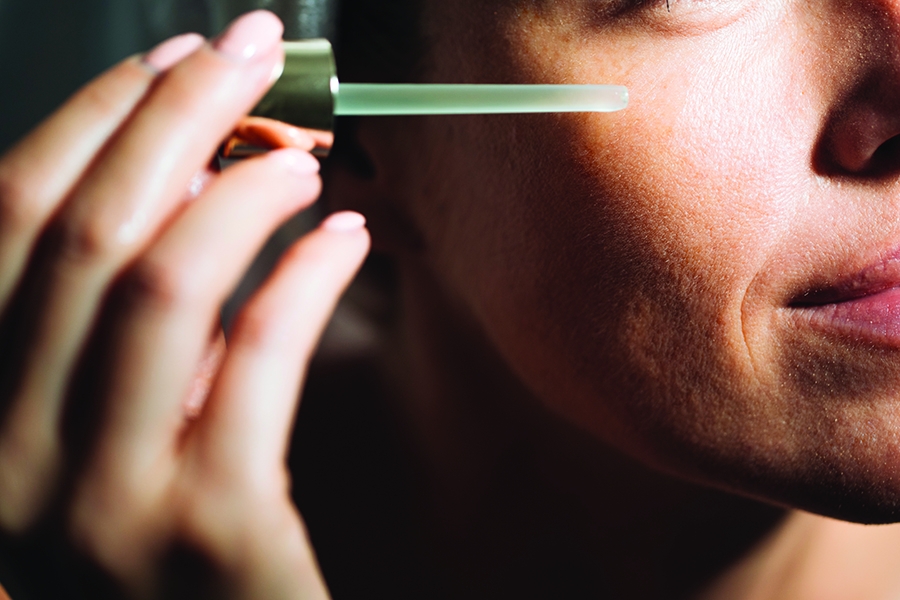Topical Application of Hyaluronic Acid: Does Size Matter?
Written by Yang S. Brooks, PhDHyaluronic acid (HA) is a natural polysaccharide (and a biodegradable polymer actually!) that is found in the eyes, skin, connective tissues, and joints of the human body. It works as a lubricant to cushion our joints and helps repair our bodies after damage or an injury has occurred. Many studies have been performed regarding the ability of HA to heal fetal scarring.
High amounts of HA are found in growing babies, infants, and small children. The natural production of hyaluronic acid decreases as we age, often resulting in undesirable outcomes. As a supplement, HA has been used to treat joint disorders, such as osteoporosis and osteoarthritis. As a treatment, HA has been used in conjunction with ocular surgeries (cataract extraction and corneal transplants, for instance) to keep the eye properly moisturized. HA can make its way into the body in various ways: orally, topically, or by injection – depending on the desired outcome or need in each specific case. It is not unheard of for shots to be injected into a person’s knee. This shot is injected as a lubricant so that he or she may walk more comfortably.
Hyaluronic acid is derived from the comb of a rooster. It can be produced synthetically, as well. One of the most interesting facts about this jelly-like substance is that it is able to retain up to 1,000 times its weight in water! It is excellent at retaining moisture. Because of this, it recently emerged as an ingredient of choice in popular dermal fillers, such as Restylane® and Juvéderm®, for restoring volume loss. The HA in the fillers works like a sponge, causing the injected areas to swell, thus, creating the plumper look some desire. The popularity of hyaluronic acid in topical skin care stems from its use in medical aesthetic procedures. It can be found in everything – serums, lotions, creams, masks, foundations, primers, blush, and lipsticks. Hyaluronic acid is the quickest way to say goodbye to dry, winter skin and hello to spring time smoothness!
THE GREAT SIZE DEBATE
Brewing within the science community is the debate of whether the molecular size of thehyaluronic acid matters when it comes to beauty treatments. Hyaluronic acid-based dermal fillers, such as Restylane® and Juvéderm®, are high molecular weight crosslinked HAs. They are used for contouring and volumizing facial wrinkles and folds, volume loss correction, and lip augmentation. The use of these fillers in cosmetic treatment has been approved by the FDA and the safety and efficacy of these fillers have been substantiated by extensive research. However, where HA in topical skin care products is concerned, things can get confusing, especially when some claim to use a new, improved form of HA that is a low or ultra-low molecular weight for better penetration.
Articles arguing against the use of low or ultra-low molecular weight HA in topical products base their argument on the scientific findings that high molecular weight HA displays anti-inflammatory and immunosuppressive properties, whereas low molecular weight HA (LMA-HA) is a potent, proinflammatory molecule. Even though these findings are credible, most of these studies are conducted in a cell culture system and, to my knowledge, only very a few of them are performed on normal human skin cells (epidermal keratinocytes, dermal fibroblasts, melanocytes, and so forth.).
When it comes to this size debate, the answer is very clear. It is, in fact, very unlikely that a topical application of low molecular weight hyaluronic acid will cause a negative result on skin. Why?
In the first place, even though a label name may say low and ultra-low molecular weight, the sizes of these molecules are still far beyond the size limit that allows penetration through the skin barrier. When applied topically, these molecules sit on the skin surface or within the topmost layer of skin and do not elicit inflammation or contact dermatitis, as they are a natural part of the body.
In the event of skin injury, the degradation of the extracellular matrix releases LMW-HA fragments in the dermis, which, together with other molecules, orchestrates the immune response. Adding LMW-HA alone to skin cells does not induce an upregulation of inflammatory cytokines, such as IL-8, IL-6, IL-beta, TNF-alpha and so forth. Instead, LMW-HA will help ramp up the skin’s self-defense system against infection during an injury. Therefore, using LMW-HA during microneedling treatments will not, as many articles have warned, exacerbate inflammation.
Secondly, unmodified, natural HA has a half-life of less than a day in the skin before it is enzymatically broken down and metabolized by the liver into byproducts, water, and carbon dioxide. It is estimated that roughly one third of HA in the body is undergoing turnover daily. In this process, high molecular weight HA is cleaved by hyaluronidase into low and ultra-low molecular weight HA and these molecules are cleared by endocytosis and macro-pinocytosis without inducing inflammation. Most studies reporting the proinflammatory functions of LMW-HA are conducted by directly adding LMW-HA to immune cells. With the physiological pathways of HA degradation and clearance lacking in these systems, their conclusions are unlikely to hold true when applying LMW-HA topically to skin.
Lastly, HA-based fillers, such as Restylane® and Juvéderm®, go through similar degradation processes. They go from high molecular weight to low molecular weight, even though they are cross-linked to promote longevity. If the LMW-HA fragments were to cause inflammation, these fillers simply could not be granted approval by the FDA. Certain articles that claim to be based in scientific fact are actually derived from broad ideas to explain a very specific and biased scenario. This leads to confusion among beauty readers and clientele alike. For instance, be careful of articles that claim that the hyaluronic acid causes cancer because it has been found in cancer cells. Hyaluronic acid is actually present in all cells, malignant or not. Articles may also claim that small molecules injected into the skin may interrupt the signaling of the cell, causing the cell to think it is injured when it is not, triggering inflammation. These articles completely disregard the idea of degradation – that the hyaluronic acid is actually removed from the skin without causing the inflammation. To best safeguard against information that may or may not be true, clients should have an honest conversation with a professional, discussing the pros and cons of each treatment to determine the correct treatment for their specific case.
So, never fear! HA does not sting like hydroxy acids do! When it comes to products like hyaluronic acid, it is definitely worth investing the time and research it takes to understand just how the product works at the molecular level. Whether dealing with dry or rough skin, facial or acne scarring, wrinkling or sagging skin, hyaluronic acid can prove to be a miracle treatment! Applied topically or injected, HA treatments last a long time and provide immediate desired results – plumping of eyebrow lines, laugh lines, and lips and a more youthful appearance for skin. When used in conjunction with a healthy lifestyle, like drinking plenty of water, getting enough sleep, and protecting from harmful ultraviolet rays, clients may absolutely expect positive, desired results. Hyaluronic acid treatment is a great and safe idea to try.
 Yang S. Brooks, PhD, is the founder and CEO of DermYoung. Brooks was an instructor in dermatology at Harvard Medical School. Brooks received her bachelor’s degree in biotechnology from Wuhan University in China and her Doctor of Philosophy in genetics and molecular medicine from Medical College of Georgia in Augusta, Georgia. Brooks completed her research fellowship at Massachusetts General Hospital and Harvard Medical School. Brook’s research focuses on skin physiology and pathology, specifically in stress-induced premature aging, wound healing, and cancer. She has authored and co-authored numerous articles in Nature, Journal of Clinical Investigation, EMBO Journal, and other industry publications. dermyoung.com
Yang S. Brooks, PhD, is the founder and CEO of DermYoung. Brooks was an instructor in dermatology at Harvard Medical School. Brooks received her bachelor’s degree in biotechnology from Wuhan University in China and her Doctor of Philosophy in genetics and molecular medicine from Medical College of Georgia in Augusta, Georgia. Brooks completed her research fellowship at Massachusetts General Hospital and Harvard Medical School. Brook’s research focuses on skin physiology and pathology, specifically in stress-induced premature aging, wound healing, and cancer. She has authored and co-authored numerous articles in Nature, Journal of Clinical Investigation, EMBO Journal, and other industry publications. dermyoung.com
